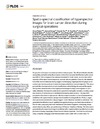Please use this identifier to cite or link to this item:
https://accedacris.ulpgc.es/jspui/handle/10553/41863
| Title: | Spatio-spectral classification of hyperspectral images for brain cancer detection during surgical operations | Authors: | Fabelo, Himar Ortega, Samuel Ravi, Daniele Kiran, B. Ravi Sosa, Coralia Bulters, Diederik Callicó, Gustavo M. Bulstrode, Harry Szolna, Adam Piñeiro, Juan F. Kabwama, Silvester Madroñal, Daniel Lazcano, Raquel J-O'Shanahan, Aruma Bisshopp, Sara Hernández, María Baez Quevedo, Abelardo Yang, Guang-Zhong Stanciulescu, Bogdan Salvador, Rubén Juárez, Eduardo Sarmiento, Roberto |
UNESCO Clasification: | 3314 Tecnología médica | Keywords: | Wavelet Entropy Resection Machine |
Issue Date: | 2018 | Project: | HypErspectraL Imaging Cancer Detection (HELiCoiD) (CONTRATO Nº 618080) | Journal: | PLoS ONE | Abstract: | Surgery for brain cancer is a major problem in neurosurgery. The diffuse infiltration into the surrounding normal brain by these tumors makes their accurate identification by the naked eye difficult. Since surgery is the common treatment for brain cancer, an accurate radical resection of the tumor leads to improved survival rates for patients. However, the identification of the tumor boundaries during surgery is challenging. Hyperspectral imaging is a noncontact, non-ionizing and non-invasive technique suitable for medical diagnosis. This study presents the development of a novel classification method taking into account the spatial and spectral characteristics of the hyperspectral images to help neurosurgeons to accurately determine the tumor boundaries in surgical-time during the resection, avoiding excessive excision of normal tissue or unintentionally leaving residual tumor. The algorithm proposed in this study to approach an efficient solution consists of a hybrid framework that combines both supervised and unsupervised machine learning methods. Firstly, a supervised pixel-wise classification using a Support Vector Machine classifier is performed. The generated classification map is spatially homogenized using a one-band representation of the HS cube, employing the Fixed Reference t-Stochastic Neighbors Embedding dimensional reduction algorithm, and performing a K-Nearest Neighbors filtering. The information generated by the supervised stage is combined with a segmentation map obtained via unsupervised clustering employing a Hierarchical K-Means algorithm. The fusion is performed using a majority voting approach that associates each cluster with a certain class. To evaluate the proposed approach, five hyperspectral images of surface of the brain affected by glioblastoma tumor in vivo from five different patients have been used. The final classification maps obtained have been analyzed and validated by specialists. These preliminary results are promising, obtaining an accurate delineation of the tumor area. | URI: | https://accedacris.ulpgc.es/handle/10553/41863 | ISSN: | 1932-6203 | DOI: | 10.1371/journal.pone.0193721 | Source: | PLoS ONE [ISSN 1932-6203], v. 13(3), e0193721 |
| Appears in Collections: | Artículos |
SCOPUSTM
Citations
139
checked on Jun 8, 2025
WEB OF SCIENCETM
Citations
120
checked on Jun 8, 2025
Page view(s)
99
checked on Oct 31, 2024
Download(s)
114
checked on Oct 31, 2024
Google ScholarTM
Check
Altmetric
Share
Export metadata
Items in accedaCRIS are protected by copyright, with all rights reserved, unless otherwise indicated.
